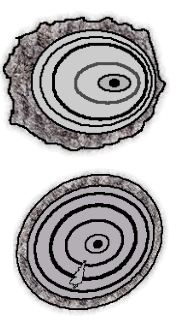Tree Growth Study with Tree Branches

Tree branches can be cut or you can use the Tree Ring Gallery at Flickr
Introduction
Forest trees grow in both height and diameter. The growth of a tree is influenced by it environment. By working with the cross section of a tree, a view of a tree round can reveal how outside influences have affected the tree’s quality of life. The cross section can also provide information about the tree’s age.
What makes those rings?
The appearance of rings in a x-section is due to the growth pattern of the tree. During regions that have seasons, trees will grow very rapidly in the spring and then not as rapidly in the late summer. The faster growth of early spring makes large cells that are light in color, the lighter colored area is called earlywood or springwood. Summer growth, which is slower, produces cells that are smaller and darker in color, these dark regions are called latewood, or summerwood. The circles created by the alternating summer and springwood are called annual rings.
The oldest layer of growth is in the center, and the newest growth rings are closest to the bark. Counting the rings can give you an estimate of how old the tree is. This method is not foolproof though. Some environmental conditions can cause the tree grow more than once during a growing season, and thus produce false rings; ring counts do not always indicate the tree’s true age.
 What other things can a cross-section tell you?
What other things can a cross-section tell you?
The width of the rings gives you clues about how favorable the growth season was. If environment conditions were good (plenty of water & sunlight) the growth rings will be wide. If conditions were not as favorable during the year, the growth rings will be narrower.
The shape of the concentric circles (annual rings) can also tell you what kind of conditions the tree lived in. In normal conditions, the rings will be in near perfect circles. Sometimes, trees don’t grow in a regular pattern, which causes the rings to be irregular. Imagine if a tree was growing next to a boulder, and it had to grow around the obstacle: the resulting rings would be a little lopsided.
Also, if a tree is damaged on the outside, as it grows that damage will become a scar on the inside. Damage could come from being cut, or fire, or disease.
Questions:
1. Name 3 things that the cross section of a tree can tell you about the tree?
2. What is a false ring?
3. The dark rings on the tree are called [earlywood / latewood ] .
4. The cells produced during the summer are [ larger / smaller ] than spring cells.
5. The oldest layer of growth is near the [ center / outside ] .
6. If a tree had to grow around an obstacle, the rings would be [ lopsided / scarred ].
7. Ring scars are caused by [ damage / earlywood ]
Examine the rounds: tree rounds have three distinct regions. The outer region, or bark, is separate from the area of wood on the inside. The center, or core, of the tree is the pith, which is small in comparison to the larger area of wood. Less noticeable region is the thin cambium, which lies between the bark and wood. Wood rays appear as lines radiating from the pith to the outside of the wood like spokes of a wheel.
The wood area is further divided into two regions. The outer area of the new growth is usually light in color and represents the live tissue called sapwood. The inner area is darker, and is dead tissue called heartwood. Sometimes this is filled with gums and resins which gives it a very dark color.
Locate all the underlined structures on your tree rounds. Make a sketch of one of them below and label each region (or structure) that is underlined above. Use shading to help distinguish the areas of sapwood and heartwood.
Identify the trees.
Minor differences will set the types of trees apart. If you look, they don’t all have the same bark texture and the rings appear different for each round. Trees that grow year round (pines and conifers) are called softwoods. Because they don’t have a distinct summer and spring growth period, their rings are not as visible, and will appear very light in color. Find the round that has the lightest colored rings. This is the pine tree. Walnut has a very dark region of heartwood due to the resin stored in it. Find the round with the darkest heartwood region – this is the walnut tree. The remaining round is the Oak tree.
Sketch the three rounds below, paying special attention to the differences in the way the wood looks. Label them Oak, Pine, and Walnut. (Use shading to help illustrate). Look at the letters on the wood. Which letter goes with which type of tree (label below).
Tree Growth Study Data
| Oak | Pine | Walnut | |
| Age of Tree (number of rings) | |||
| Best Growth Year (widest ring) | |||
| Identifiable Scar Regions (years) | |||
| Diameter (in centimeters) |
Related Resources
Comparing Monocots and Dicots Comparison – color the leaves, stems, and germination pattern for the two types of plants
Help Wanted – descriptions of plant jobs (classifieds), students guess the structure best suited
Photosynthesis Reading Guide – worksheet to complete when reading CK12 text on photosynthesis
How Much Water is In a Plant? – Weigh grapes or plant clippings to determine how much water plants contain